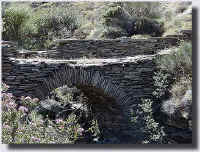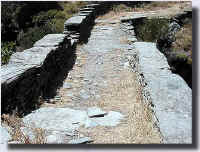DIPOTAMATA
 Dipotamata
is a river-basin of extreme natural beauty, with a length of about 7
kilometers, in the south-east side of the island,
between Syneti, Paleokastro
and Kochylou. Water these
days is less, but even in drought times it doesn't stop. The natural
environment is unspoiled, since the traffic has stopped since the last
35 years. As a consequence the vegetation is very thick (oleanders,
mulberry-trees, fig-trees, oak-trees, bushes, reeds, rushes,
blackberries, mint, osiers, ivies). The whole area is a shelter for a
variety of animals, such as weasels, badgers, hares, snakes and birds (partridges
mainly).
Dipotamata
is a river-basin of extreme natural beauty, with a length of about 7
kilometers, in the south-east side of the island,
between Syneti, Paleokastro
and Kochylou. Water these
days is less, but even in drought times it doesn't stop. The natural
environment is unspoiled, since the traffic has stopped since the last
35 years. As a consequence the vegetation is very thick (oleanders,
mulberry-trees, fig-trees, oak-trees, bushes, reeds, rushes,
blackberries, mint, osiers, ivies). The whole area is a shelter for a
variety of animals, such as weasels, badgers, hares, snakes and birds (partridges
mainly).
 The
gorge is crossed by a wide slated cobbled road (the only road
connecting Korthi with Chora till 1950). In the intersecting point
with the river, there is an arch-shaped bridge and occasionally small
fountains. There are also other narrow step-like paths connecting the
other villages of the area with the fields and the water mills. In
good condition there are also (apart from the paths, the stone-walls,
the water-mills and their auxiliary constructions) sheep-cotes,
stables, lodgings, barns, threshing floors and country churches. But
the most important structures of the area are the
water-mills.
The
gorge is crossed by a wide slated cobbled road (the only road
connecting Korthi with Chora till 1950). In the intersecting point
with the river, there is an arch-shaped bridge and occasionally small
fountains. There are also other narrow step-like paths connecting the
other villages of the area with the fields and the water mills. In
good condition there are also (apart from the paths, the stone-walls,
the water-mills and their auxiliary constructions) sheep-cotes,
stables, lodgings, barns, threshing floors and country churches. But
the most important structures of the area are the
water-mills.
 The
reason that in Dipotamata was built a large number of water-mills, was
the particularly favourable conditions for establishing and operating
them: plenty of running water, good access through the paths,
protected environment, small distance from villages, etc. Today can be
seen (in good condition, in ruins or in traces) 22 water-mills in all
the gorge. Most of them are in very good shape. In a few of them there
are neighbouring or adjacent auxiliary buildings, such as a room for
the miller to spend the night, sheep-cote, stable or store room.
Hydraulic works of big importance and extent for the time and its
technological level were supplying and often netting the water-mills. In narrow places of the gorge there were dams, which
were forming lakes, to collect water for watering purposes and the
functioning of the water-mills. From there, canals were guiding the
water in the millpond and eventually into the hole of the machinery of
the mill. The remaining water and water coming out of the mill (having
rotated its wheel) was guided to the canal of the next water-mill.
The
reason that in Dipotamata was built a large number of water-mills, was
the particularly favourable conditions for establishing and operating
them: plenty of running water, good access through the paths,
protected environment, small distance from villages, etc. Today can be
seen (in good condition, in ruins or in traces) 22 water-mills in all
the gorge. Most of them are in very good shape. In a few of them there
are neighbouring or adjacent auxiliary buildings, such as a room for
the miller to spend the night, sheep-cote, stable or store room.
Hydraulic works of big importance and extent for the time and its
technological level were supplying and often netting the water-mills. In narrow places of the gorge there were dams, which
were forming lakes, to collect water for watering purposes and the
functioning of the water-mills. From there, canals were guiding the
water in the millpond and eventually into the hole of the machinery of
the mill. The remaining water and water coming out of the mill (having
rotated its wheel) was guided to the canal of the next water-mill.


 Dipotamata
is a river-basin of extreme natural beauty, with a length of about 7
kilometers, in the south-east side of the island,
between Syneti, Paleokastro
and Kochylou. Water these
days is less, but even in drought times it doesn't stop. The natural
environment is unspoiled, since the traffic has stopped since the last
35 years. As a consequence the vegetation is very thick (oleanders,
mulberry-trees, fig-trees, oak-trees, bushes, reeds, rushes,
blackberries, mint, osiers, ivies). The whole area is a shelter for a
variety of animals, such as weasels, badgers, hares, snakes and birds (partridges
mainly).
Dipotamata
is a river-basin of extreme natural beauty, with a length of about 7
kilometers, in the south-east side of the island,
between Syneti, Paleokastro
and Kochylou. Water these
days is less, but even in drought times it doesn't stop. The natural
environment is unspoiled, since the traffic has stopped since the last
35 years. As a consequence the vegetation is very thick (oleanders,
mulberry-trees, fig-trees, oak-trees, bushes, reeds, rushes,
blackberries, mint, osiers, ivies). The whole area is a shelter for a
variety of animals, such as weasels, badgers, hares, snakes and birds (partridges
mainly). The
gorge is crossed by a wide slated cobbled road (the only road
connecting Korthi with Chora till 1950). In the intersecting point
with the river, there is an arch-shaped bridge and occasionally small
fountains. There are also other narrow step-like paths connecting the
other villages of the area with the fields and the water mills. In
good condition there are also (apart from the paths, the stone-walls,
the water-mills and their auxiliary constructions) sheep-cotes,
stables, lodgings, barns, threshing floors and country churches. But
the most important structures of the area are the
The
gorge is crossed by a wide slated cobbled road (the only road
connecting Korthi with Chora till 1950). In the intersecting point
with the river, there is an arch-shaped bridge and occasionally small
fountains. There are also other narrow step-like paths connecting the
other villages of the area with the fields and the water mills. In
good condition there are also (apart from the paths, the stone-walls,
the water-mills and their auxiliary constructions) sheep-cotes,
stables, lodgings, barns, threshing floors and country churches. But
the most important structures of the area are the The
reason that in Dipotamata was built a large number of water-mills, was
the particularly favourable conditions for establishing and operating
them: plenty of running water, good access through the paths,
protected environment, small distance from villages, etc. Today can be
seen (in good condition, in ruins or in traces) 22 water-mills in all
the gorge. Most of them are in very good shape. In a few of them there
are neighbouring or adjacent auxiliary buildings, such as a room for
the miller to spend the night, sheep-cote, stable or store room.
Hydraulic works of big importance and extent for the time and its
technological level were supplying and often netting the water-mills. In narrow places of the gorge there were dams, which
were forming lakes, to collect water for watering purposes and the
functioning of the water-mills. From there, canals were guiding the
water in the millpond and eventually into the hole of the machinery of
the mill. The remaining water and water coming out of the mill (having
rotated its wheel) was guided to the canal of the next water-mill.
The
reason that in Dipotamata was built a large number of water-mills, was
the particularly favourable conditions for establishing and operating
them: plenty of running water, good access through the paths,
protected environment, small distance from villages, etc. Today can be
seen (in good condition, in ruins or in traces) 22 water-mills in all
the gorge. Most of them are in very good shape. In a few of them there
are neighbouring or adjacent auxiliary buildings, such as a room for
the miller to spend the night, sheep-cote, stable or store room.
Hydraulic works of big importance and extent for the time and its
technological level were supplying and often netting the water-mills. In narrow places of the gorge there were dams, which
were forming lakes, to collect water for watering purposes and the
functioning of the water-mills. From there, canals were guiding the
water in the millpond and eventually into the hole of the machinery of
the mill. The remaining water and water coming out of the mill (having
rotated its wheel) was guided to the canal of the next water-mill.